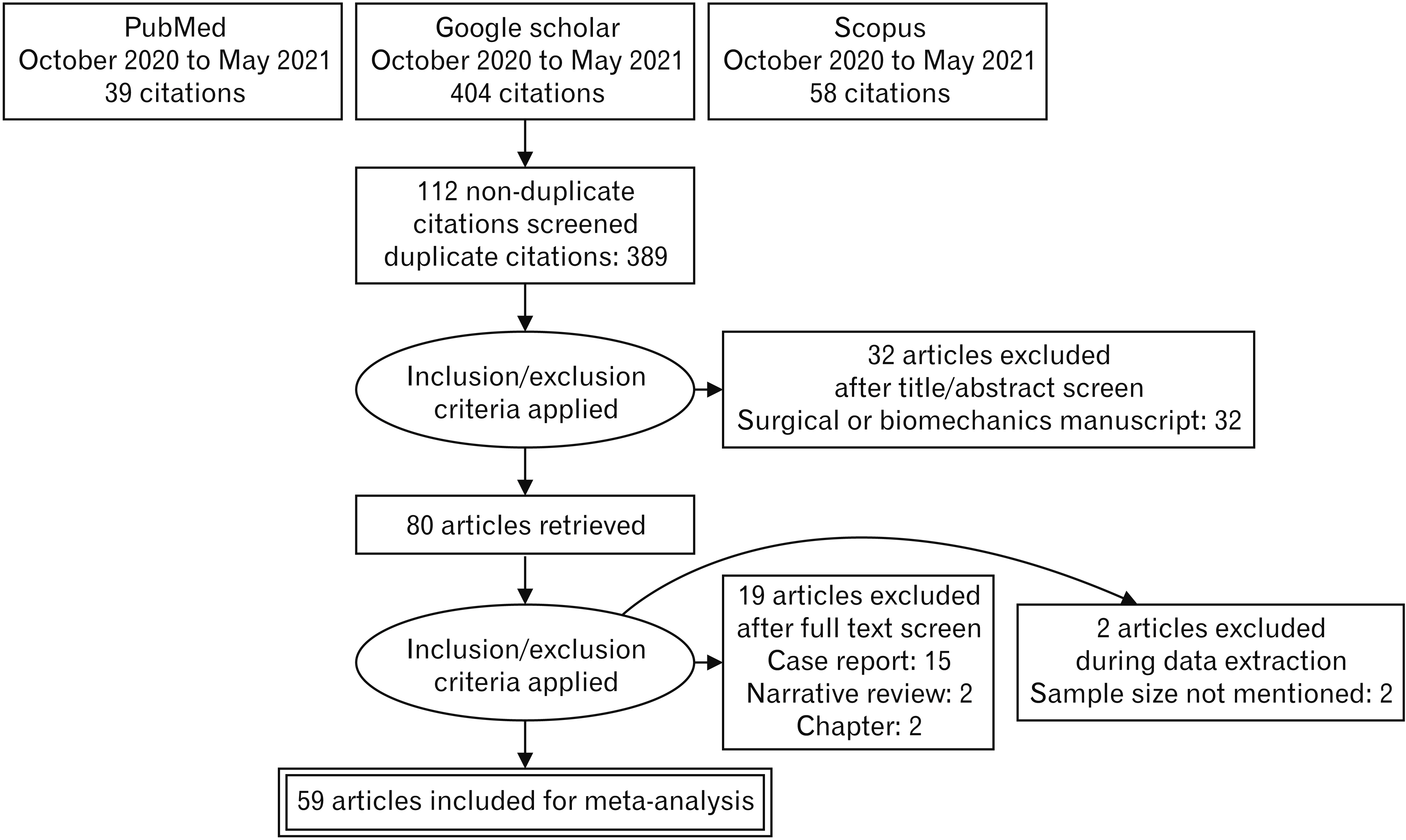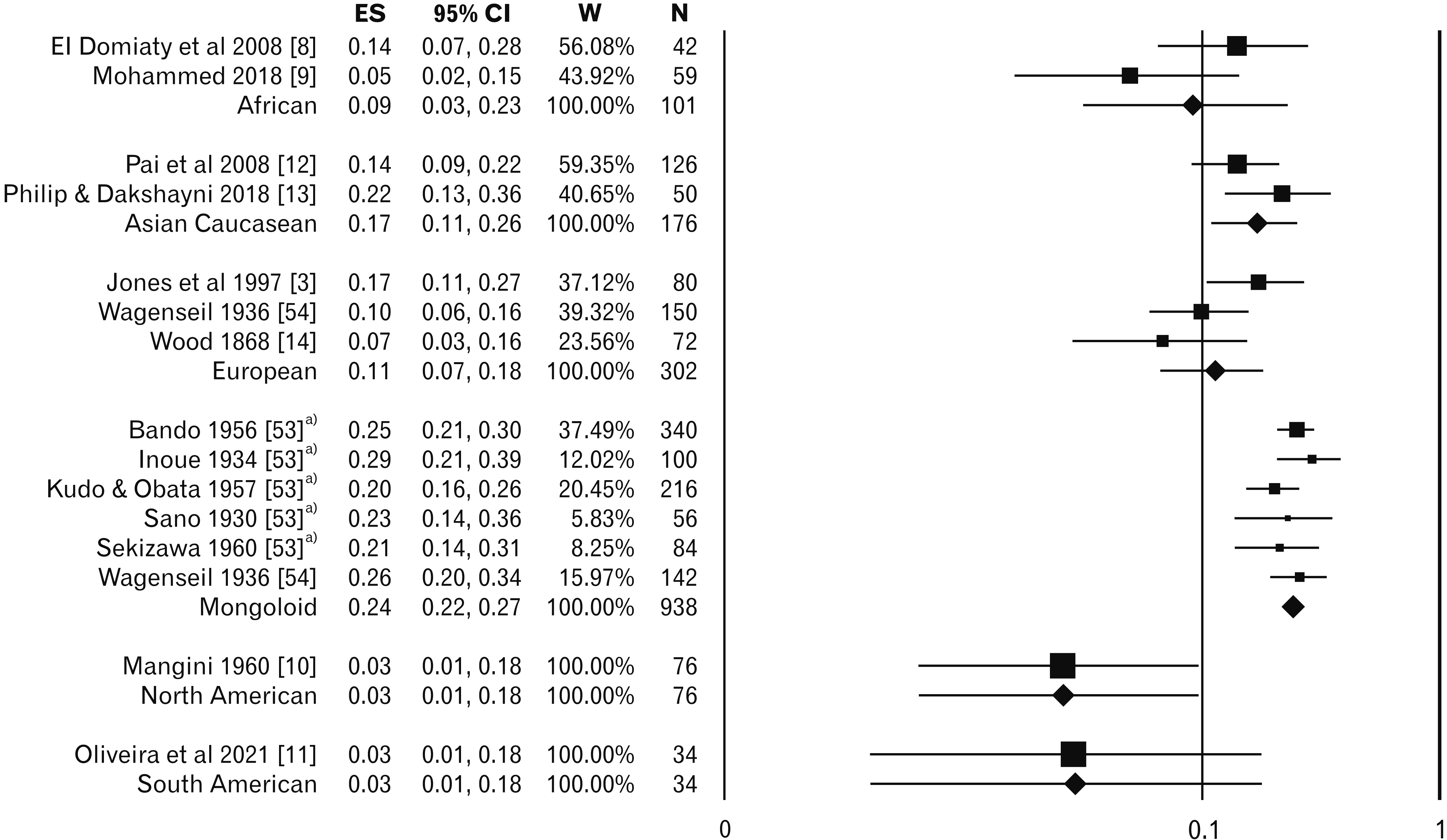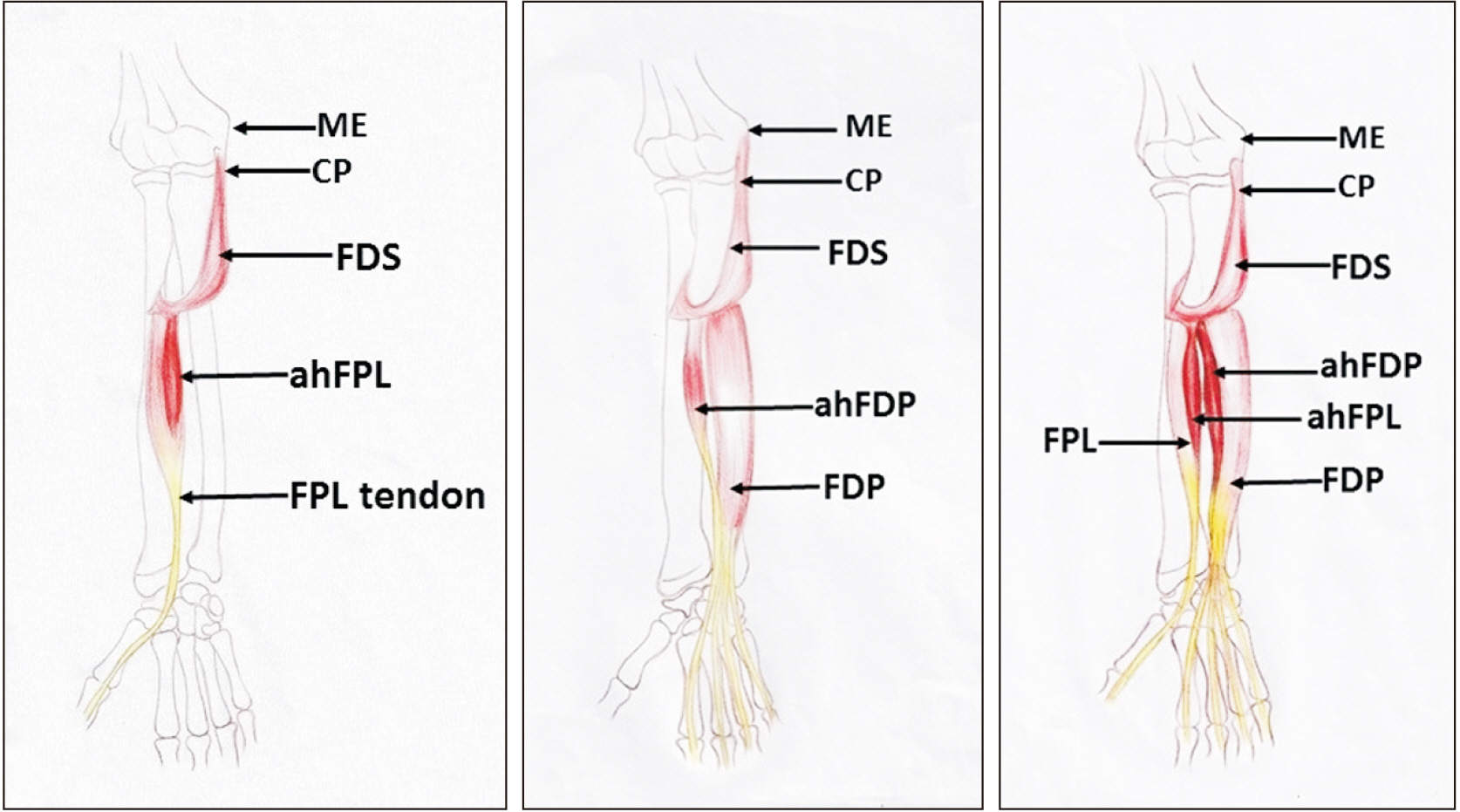Anat Cell Biol.
2022 Mar;55(1):3-13. 10.5115/acb.21.141.
The prevalence and distribution of the variants of Gantzer’s muscle: a meta-analysis of cadaveric studies
- Affiliations
-
- 1Department of Anatomy, All India Institute of Medical Sciences Patna, Patna, India
- 2Department of Anatomy, All India Institute of Medical Sciences Bathinda, Bathinda, 3 Department of Anatomy, All India Institute of Medical Sciences Rishikesh, Rishikesh, India
- KMID: 2527663
- DOI: http://doi.org/10.5115/acb.21.141
Abstract
- The Gantzer’s muscle is often present in the flexor compartment of the forearm. It lies underneath flexor digitorum superficialis and compresses the anterior interosseous nerve. Furthermore, this muscle frequently bestows an accessory muscle of flexor pollicis longus or flexor digitorum profundus, or sometimes together. The current meta-analysis aims to compute the prevalence of subtypes of Gantzer’s muscle. Major electronic databases (PubMed, Scopus, Google Scholar, etc.) were searched for title and abstract. After removing the duplicate citations, the titles/abstracts were shortlisted with the help of inclusion and exclusion criteria. The shortlisted titles/abstracts were downloaded or collected from the library. The data of all subtypes of Gantzer’s muscle were pooled from shortlisted published manuscripts for meta-analysis. The pooled estimate of other anatomical characteristics was also observed. A total of 59 cadaveric studies of sample size 5,903 were evaluated for pooled prevalence of flexor pollicis longus (accessory head). Similarly, the authors evaluated 14 studies of 1,627 upper limbs for flexor digitorum profundus (accessory head). The unit of analysis was per 100 upper limbs. The Pooled prevalence of accessory muscle of flexor pollicis longus and flexor digitorum profundus were 48% (95% CI, 44%–52%) and 17% (95% CI, 13%–21%), respectively. The Gantzer’s muscle is present in 2/3rd of the upper limbs. Accessory head of flexor pollicis longus is almost three times more common than the accessory head of flexor digitorum profundus. A classification of Gantzer’s muscle is needed to reduce the ignorance of these variants.
Keyword
Figure
Reference
-
References
1. Zdilla MJ, Pacurari P, Celuck TJ, Andrews RC, Lambert HW. 2019; A Gantzer muscle arising from the brachialis and flexor digitorum superficialis: embryological considerations and implications for median nerve entrapment. Anat Sci Int. 94:150–3. DOI: 10.1007/s12565-018-0466-6. PMID: 30382571.
Article2. Gantzer KFL. 1813. [Dissertation on the anatomical variations of the muscular structure: with the consent of the highly esteemed medical class chaired by Charles Asmund Rudolph]. Typis Joannis Friderici Starckii;Berolini: Latin. DOI: 10.1007/s12565-018-0466-6.3. Jones M, Abrahams PH, Sañudo JR, Campillo M. 1997; Incidence and morphology of accessory heads of flexor pollicis longus and flexor digitorum profundus (Gantzer’s muscles). J Anat. 191(Pt 3):451–5.
Article4. Yang K, Jung SJ, Lee H, Choi IJ, Lee JH. 2017; Topographical relations between the Gantzer’s muscle and neurovascular structures. Surg Radiol Anat. 39:843–8.
Article5. Gyambibi A, Lemelin P. 2013; Comparative and quantitative myology of the forearm and hand of prosimian primates. Anat Rec (Hoboken). 296:1196–206. DOI: 10.1002/ar.22721. PMID: 23740715.
Article6. Roy J, Henry BM, Pękala PA, Vikse J, Ramakrishnan PK, Walocha JA, Tomaszewski KA. 2015; The prevalence and anatomical characteristics of the accessory head of the flexor pollicis longus muscle: a meta-analysis. PeerJ. 3:e1255. DOI: 10.7717/peerj.1255. PMID: 26557419. PMCID: PMC4636409.
Article7. Henry BM, Tomaszewski KA, Ramakrishnan PK, Roy J, Vikse J, Loukas M, Tubbs RS, Walocha JA. 2017; Development of the anatomical quality assessment (AQUA) tool for the quality assessment of anatomical studies included in meta-analyses and systematic reviews. Clin Anat. 30:6–13. DOI: 10.1002/ca.22799. PMID: 27718281.
Article8. El Domiaty MA, Zoair MM, Sheta AA. 2008; The prevalence of accessory heads of the flexor pollicis longus and the flexor digitorum profundus muscles in Egyptians and their relations to median and anterior interosseous nerves. Folia Morphol (Warsz). 67:63–71. PMID: 18335416.9. Mohammed WHE. 2018. Prevalence and morphology of Gantzer’s muscle: a cadaveric based study [theses]. Omdurman Islamic University;Omdurman:10. Mangini U. 1960; Flexor pollicis lungus muscle. Its morphology and clinical significance. J Bone Joint Surg Am. 42:467–70. PMID: 13853793.11. Oliveira KM, Breder CB, Ponte EF, Cordeiro AF, Oliveira MFS, Gomes WAPR, Gonçalves MF, Gonçalves GR, Grecco LH, Meggiolaro EDA, Silva JGBPCP, López CAC. 2021; Mar. 17. The accessory heads of the muscles flexor pollicis longus and flexor digitorum profundus (Gantzer muscle) - an anatomical study in Brazilian cadavers. Morphologie. [Epub]. https://doi.org/10.1016/j.morpho.2021.02.010. DOI: 10.1016/j.morpho.2021.02.010. PMID: 33744125.
Article12. Pai MM, Nayak SR, Krishnamurthy A, Vadgaonkar R, Prabhu LV, Ranade AV, Janardhan JP, Rai R. 2008; The accessory heads of flexor pollicis longus and flexor digitorum profundus: incidence and morphology. Clin Anat. 21:252–8. DOI: 10.1002/ca.20612. PMID: 18351652.
Article13. Philip SE, Dakshayani KR. 2018; A morphological study of a rare variant of Gantzer’s muscle. Int J Anat Res. 6:4811–4.
Article14. Wood J. 1868; XVII. Variations in human myology observed during the winter session of 1867-68 at King’s College, London. Proc Royal Soc London. 16:483–525.
Article15. al-Qattan MM. 1996; Gantzer’s muscle. An anatomical study of the accessory head of the flexor pollicis longus muscle. J Hand Surg Br. 21:269–70.16. Bagoji IB, Doshi MA, Hadimani GA, Bannur BM, Patil BG, Patil BS, Das KK. 2017; Incidence and morphology of the accessory head of the flexor pollicis longus muscle (Gantzer’s muscle) in South Indian population. J Anat Soc India. 66(Suppl 1):S50.
Article17. Bajpe R, Tarakeshwari R, Shubha R. 2015; Gantzer muscles; a study on 50 cadaveric upper limbs. Nat J Clin Anat. 4:179–85. DOI: 10.4103/2277-4025.295982. PMID: 5d0d37d6bf624315801cb6a4a00832dd. PMID: 5d0d37d6bf624315801cb6a4a00832dd.
Article18. Afroze MKH, Umesh SN, Sangeeta M, Varalakshmi KL, Tiwari S. 2020; An anatomical and morphological study on accessory head of flexor pollicis longus (Gantzer’s muscles) and its clinical emphasis. Int J Anat Res. 8:7568–71.
Article19. Ballesteros DR, Forero PL, Ballesteros LE. 2019; Accessory head of the flexor pollicis longus muscle: anatomical study and clinical significance. Folia Morphol (Warsz). 78:394–400. DOI: 10.5603/fm.a2018.0091. PMID: 30299534.
Article20. Bangarayya V, Narayana P, Pillai T, Priyanka K. 2018; A study on accessory muscle of flexor compartment of forearm. IOSR J Dent Med Sci. 17:18–21.21. Bilecenoglu B, Uz A, Karalezli N. 2005; Possible anatomic structures causing entrapment neuropathies of the median nerve: an anatomic study. Acta Orthop Belg. 71:169–76. PMID: 16152850.22. Burute P, Vatsalaswamy P. 2017; Accessory heads of forearm flexors and flexor carpi radialis brevis: a cadaveric study with clinical significance. Int J Anat Res. 5:3698–703. DOI: 10.16965/ijar.2017.145.
Article23. Caetano EB, Sabongi JJ, Vieira LÂ, Caetano MF, Moraes DV. 2015; Gantzer muscle. An anatomical study. Acta Ortop Bras. 23:72–5. DOI: 10.1590/1413-78522015230200955. PMID: 27069404. PMCID: PMC4813407.
Article24. Chakravarthi KK, Ks S, Venumadhav N, Sharma A, Kumar N. 2014; Anatomical variations of brachial artery - its morphology, embryogenesis and clinical implications. J Clin Diagn Res. 8:AC17–20. DOI: 10.7860/jcdr/2014/10418.5308. PMID: 25653931. PMCID: PMC4316237.
Article25. Dellon AL, Mackinnon SE. 1987; Musculoaponeurotic variations along the course of the median nerve in the proximal forearm. J Hand Surg Br. 12:359–63. DOI: 10.1016/0266-7681_87_90189-6. PMID: 3437205.
Article26. Desai RR, Desai AR, Ambali MP. 2017; Incidence of accessory head of flexor pollicis longus (only in males) and its clinical significance. Nat J Integr Res Med. 8:88–91.27. Dolderer JH, Prandl EC, Kehrer A, Beham A, Schaller HE, Briggs C, Kelly JL. 2011; Solitary paralysis of the flexor pollicis longus muscle after minimally invasive elbow procedures: anatomical and clinical study of the anterior interosseous nerve. Plast Reconstr Surg. 127:1229–36. DOI: 10.1097/prs.0b013e3182043ac0. PMID: 21364424.
Article28. Dykes J, Anson BJ. 1944; The accessory tendon of the flexor pollicis longus muscle. Anat Rec. 90:83–7. DOI: 10.1002/ar.1090900111.
Article29. Gunnal S, Siddiqui A, Daimi S, Farooqui M, Wabale R. 2013; A study on the accessory head of the flexor pollicis longus muscle (Gantzer’s muscle). J Clin Diagn Res. 7:418–21.30. Hemmady MV, Subramanya AV, Mehta IM. 1993; Occasional head of flexor pollicis longus muscle: a study of its morphology and clinical significance. J Postgrad Med. 39:14–6. PMID: 8295137.31. Herrold CB, Cook RL, Burkett JT, Hobeika NA, Zdilla MJ, Lambert HW. 2020; The Gantzer muscle: an expanded study of this variant forearm muscle. FASEB J. 34:1–1. DOI: 10.1096/fasebj.2020.34.s1.05673.
Article32. Kara A, Elvan O, Yildiz S, Ozturk H. 2012; Accessory head of flexor pollicis longus muscle in fetuses and adult cadavers and its relation to anterior interosseous nerve. Clin Anat. 25:601–8. DOI: 10.1002/ca.21296. PMID: 22038878.
Article33. Khade B, Chaudhari G, Yadav N, Mangalgiri A. 2020; Anatomical study of accessory head of flexor pollicis longus and its clinical significance. Natl J Clin Anat. 9:151–4. DOI: 10.4103/njca.njca_59_20.
Article34. Kida M. 1988; The morphology of Gantzer’s muscle, with special reference to the morphogenesis of the flexor digitorum superficialis. Kaibogaku Zasshi. 63:539–46. Japanese. DOI: 10.4103/njca.njca_59_20.35. Kumari A, Kumar S, Akhtar MJ, Ratnesh R, Kumar V. 2017; Morphological study of accessory heads of deep flexor muscle of forearm. J Med Sci Clin Res. 5:24172–6. DOI: 10.18535/jmscr/v5i7.142.
Article36. Le Double AF, Berry RJA. 1897. Treatise on variations of the muscular system of man: and their significance from the point of view of zoological anthropology. Schleicher frères;Paris: French. DOI: 10.18535/jmscr/v5i7.142.37. Mahakkanukrauh P, Surin P, Ongkana N, Sethadavit M, Vaidhayakarn P. 2004; Prevalence of accessory head of flexor pollicis longus muscle and its relation to anterior interosseous nerve in Thai population. Clin Anat. 17:631–5. DOI: 10.1002/ca.20016. PMID: 15495169.
Article38. Malhotra VK, Sing NP, Tewari SP. 1982; The accessory head of the flexor pollicis longus muscle and its nerve supply. Anat Anz. 151:503–5. PMID: 7137578.39. Matsunaga K, Matsuzaki A, Miyauchi R. 2000; Relationship of Gantzer’s muscle (accessory head of flexor pollicis longus) with median and anterior interosseous nerves. Orthop Traumatol. 49:845–9.
Article40. Mustafa AYAE, Alkushi AG, Alasmari WAM, Ali Sakran AME, Elamin AM. 2016; Anatomical study of theaccessory heads of the deep flexor muscles of theforearm (Gantzer muscles). Int J Anat Res. 4:2984–7.41. Mori M. 1964; Statistics on the musculature of the Japanese. Okajimas Folia Anat Jpn. 40:195–300. DOI: 10.2535/ofaj1936.40.3_195. PMID: 14213705.
Article42. Ravi Prasanna KH, Das AK, Kulkarni AL. 2019; Study of morphology of Gantzer muscle in forearm and its clinical significance. Sch Int J Anat Physiol. 2:261–4.43. Riveros A, Olave E, Sousa-Rodrigues C. 2015; Anatomical study of the accessory head of the flexor pollicis longus muscle and its relationship to the anterior interosseous nerve in Brazilian individuals. Int J Morphol. 33:31–5.44. Sato S. 1969; Statistical studies on the anomalous muscles of the Kyushu-Japanese. 4. The muscles of the upper limb. Kurume Med J. 16:69–81. DOI: 10.2739/kurumemedj.16.69. PMID: 5195962.45. Sharma M, Chabbra U, Kaushal S, Patnaik VVG, Prashar R. 2008; Accessory head of flexor pollicis longus muscle. J Exerc Sci Physiother. 4:15–8. DOI: 10.1002/ca.21296. PMID: 22038878.46. Shayo J, Pokhojaev A, Medlej B. 2015. The Gantzer’s muscle: an anatomical and US study [Internet]. Labome.Org-Research;Princeton, NJ: Available from: http://www.labome.org/research/The-Gantzer-s-muscle-an-anatomical-and-US-study.html.cited 2021 May 27.47. Shirali S, Hanson M, Branovacki G, Gonzalez M. 1998; The flexor pollicis longus and its relation to the anterior and posterior interosseous nerves. J Hand Surg Br. 23:170–2. DOI: 10.1016/s0266-7681(98)80167-8. PMID: 9607652.
Article48. Tamang BK, Sinha P, Sarda RK, Shilal P, Murlimanju BV. 2013; Incidence and morphology of accessory head of Flexor pollicis longus muscle--an anatomical study. J Evol Med Dent Sci. 2:6800.
Article49. Tubbs RS, Custis JW, Salter EG, Wellons JC 3rd, Blount JP, Oakes WJ. 2006; Quantitation of and superficial surgical landmarks for the anterior interosseous nerve. J Neurosurg. 104:787–91. DOI: 10.3171/jns.2006.104.5.787. PMID: 16703884.
Article50. Uyaroglu FG, Kayalioglu G, Erturk M. 2006; Incidence and morphology of the accessory head of the flexor pollicis longus muscle (Gantzer’s muscle) in a Turkish population. Neurosciences (Riyadh). 11:171–4.51. Oh CS, Chung IH, Koh KS. 2000; Anatomical study of the accessory head of the flexor pollicis longus and the anterior interosseous nerve in Asians. Clin Anat. 13:434–8. DOI: 10.1002/1098-2353(2000)13:6<434::aid-ca7>3.0.co;2-4. PMID: 11111895.
Article52. Yu JM, Yoon SP, Kim J. 2018; Accessory head of flexor pollicis longus in Jeju islander cadavers. J Med Life Sci. 15:16–8. DOI: 10.22730/jmls.2018.15.1.16.
Article53. Tomizawa I. 1986; Arthropological studies on variation of the muscles of upper extremity of the Ainu. Sapporo Med J. 55:101–23.54. Wagenseil F. 1936; Investigations into the musculature of the Chinese. Z Für Morphol Anthropol. 36:39–150. German.55. Dubois de Mont-Marin G, Laulan J, Le Nen D, Bacle G. 2021; Topographic anatomy of structures liable to compress the median nerve at the elbow and proximal forearm. Orthop Traumatol Surg Res. 107:102813. DOI: 10.1016/j.otsr.2021.102813. PMID: 33482406.
Article56. Cıftçıoğlu E, Kopuz C, Corumlu U, Demır MT. 2011; Accessory muscle in the forearm: a clinical and embryological approach. Anat Cell Biol. 44:160–3. DOI: 10.5115/acb.2011.44.2.160. PMID: 21829760. PMCID: PMC3145845.
Article57. Tabib W, Aboufarah F, Asselineau A. 2001; Compression of the anterior interosseous nerve by Gantzer’s muscle. Chir Main. 20:241–6. French. DOI: 10.5115/acb.2011.44.2.160.58. Degreef I, De Smet L. 2004; Anterior interosseous nerve paralysis due to Gantzer’s muscle. Acta Orthop Belg. 70:482–4.59. Nakano KK, Lundergran C, Okihiro MM. 1977; Anterior interosseous nerve syndromes. Diagnostic methods and alternative treatments. Arch Neurol. 34:477–80. DOI: 10.1001/archneur.1977.00500200037007. PMID: 196582.60. Rodner CM, Tinsley BA, O’Malley MP. 2013; Pronator syndrome and anterior interosseous nerve syndrome. J Am Acad Orthop Surg. 21:268–75. DOI: 10.5435/jaaos-21-05-268. PMID: 23637145.
Article
- Full Text Links
- Actions
-
Cited
- CITED
-
- Close
- Share
- Similar articles
-
- Double Gantzer's Muscles by Four Muscle Bellies and Its Clinical Significance: A Case Report
- Concomitant Variations in Flexor Digitorum Superficialis: A Case Report
- Beta-Meta: a meta-analysis application considering heterogeneity among genome-wide association studies
- A Review of HPV Prevalence Research
- A bilateral gastrocnemius tertius coexisting with a unilateral two-headed plantaris muscle





